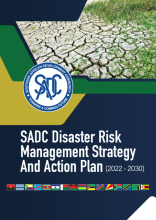The Southern Africa Development Community (SADC) faces a wide range of natural hazards either single or hybrid and human-induced risks, such as drought, floods, landslides, human and animal disease, pests, earthquakes, and urban and wildfires, that impact on and reduce the full realization of the benefits of SADC Vision 2050. The impacts of the Tropical Cyclones Idai and Kenneth, persistent food insecurity and the COVID-19 pandemic demonstrated increased magnitude and frequency, as well as the severity and interconnectedness of the risks and cascading impacts. While hazards are often associated with the region's diverse geo-climatic circumstances, there are other shocks that continuously pose risks to the socio-economic performance, as well as vulnerabilities amongst our communities and people.
Effective disaster risk management (DRM) in the region has been reactive and interim due to deficiencies in risk governance, and development of responsive frameworks, limitations in institutional arrangements, inadequate investments in disaster risk reduction (DRR), risk informed development, and climate change-related knowledge management.
To respond to this challenge, the SADC Region has developed the SADC Disaster Risk Management Strategy and Action Plan 2022-2030. The Strategy outlines the need for the advancement of comprehensive DRM governance approaches and knowledge management, streamlining and strengthening of institutions, in particular the recently operationalised SADC
Humanitarian and Emergency Operations Centre (SHOC) to also advance the development and implementation of transboundary coordination frameworks, capacity development, enabling DRR investments, partnerships and resilience building. The Strategy encompasses a full DRM Action Plan and monitoring framework that aims to promote greater effectiveness in early warning, preparedness, response, recovery and gender equity, urban resilience, environmental management and climate adaptation considerations all anchored within the Risk Informed Development principles and practices.

